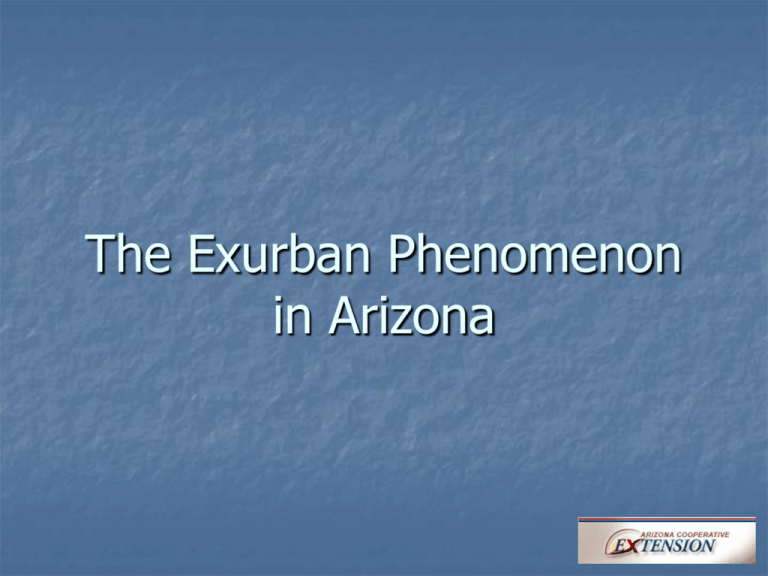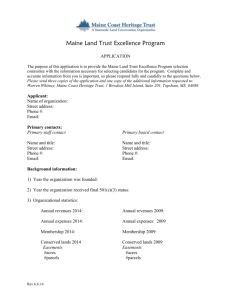Building the Capacity of Extension Community Resource
advertisement

The Exurban Phenomenon in Arizona Learning Objectives Compare/contrast definitions of “Exurban” Understand how exurban trends are affecting the state and your community Be able to discuss both positive and negative impacts of exurban growth Think about ways you can become involved in managing exurban changes What Does “Exurban” Mean, Anyway?? Large-scale permanent settlement by urban people in non-metropolitan areas beyond typical commuting distances A development type that blurs the distinction between suburban and rural A settlement type that is characterized by more land consumption per capita and a mix of populations and housing What Does “Exurban” Mean, Anyway?? “A small, usually prosperous community situated beyond the suburbs of a city.” – dictionary.com "They begin as embryonic subdivisions of a few hundred homes at the far edge of beyond, surrounded by scrub. Then, they grow first gradually, but soon with explosive force - attracting stores, creating jobs and struggling to keep pace with the need for more schools, more roads, more everything. And eventually, when no more land is available and home prices have skyrocketed, the whole cycle starts again, another 15 minutes down the turnpike.” –wikipedia.com What Does Exurban Development Look Like? What Does Exurban Development Look Like? Doesn’t look the same in all communities Different land use patterns Changing economies Unique commuting patterns Different income streams Home prices Fiscal/tax implications New demands for goods and services Conflicts between “established” and new attitudes Who Are These Exurbanites? They’re a very diverse group Not all exurbanite communities are alike! Age Income Housing Type We’re still learning about them What Factors Are Driving Exurban Growth? Population Growth Demographic Changes Desire for a “Rural Lifestyle” Desire for land Housing market dynamics Arizona Statutes that deal with development Unregulated Lot Splits State law regarding the splitting of parcels Large parcel, like a ranch, can be broken into numerous 36-acre or greater parcels so long as each lot is at least 36-acres or larger - commonly called “records of survey” or “40’s” Each 36-acre parcel can be split 5 more times by subsequent owners if they meet the minimum lot size for zoning Except for “records of survey” no one owner can split more than 5 times Information courtesy of Mark Apel, Arizona Cooperative Extension The Result A 400-Acre parcel Becomes 10 40-Acre Parcels 40 40 40 40 40 acres acres acres acres acres 40 40 acres acres 40 acres 40 40 acres acres New Owner Splits Five Times 8 8 8 8 8 Acres Acres Acres Acres Acres Each 40-acre parcel becomes five 8-acre parcels New Owner Splits Twice 4 acres 4 acres Each 8-acre parcel becomes two 4-acre parcels End Result: 100 Lots All graphics courtesy of Mark Apel, Arizona Cooperative Extension Lot Splitting: An Example Hereford Area 1996 Lot Splitting: An Example Hereford Area Now What Are the Negative Impacts of Exurban Growth? Photo courtesy of Mark Apel Negative Cultural Impacts What Are the Negative Impacts of Exurban Growth? Planning & Zoning Issues Unmaintained, impassable roads Septic tank failures Inadequate water supplies Flooding Negative Impacts Environmental Impacts Habitat Fragmentation Air Quality Erosion Invasive Species/Predatory Pets Water Supply and Quality Change in Fire Regime Negative Impacts Fiscal Impacts County services overburdened More rooftops doesn’t necessarily mean bigger fiscal surplus: some land use/housing types don’t always pay for themselves General taxpayer often subsidizes minority “Wildcat” development can create an infrastructure deficit that may have to be paid for later What Are the Positive Impacts of Exurban Growth? Provides people with a lifestyle they crave Is a boon for Arizona real estate industry Economic and cultural diversity are increasing Some exurbanites are willing to become involved in community problem-solving New demands for goods and services Positive Impacts Potential for increased tax revenues Potential for an increase in “basic” income Many exurbanites share similar open space values with traditional rural residents Exurbanization has the potential to represent an environmental transition zone between urban and rural areas Data Available to Track Exurbanization Population Growth Population Density Migration (in and out) Location of Residence vs. Work Commute Times Residential Building Permits (% Increase) Dividends, Interest and Rent Income Transfer Payments An Overview From 1982 to 1997, the total amount of developed land in the West grew by 2 million acres, or about half an acre per person, through conversion of agricultural land, forest and natural open space. Arizona more than doubled its population and tripled its employment between 1969 and 2003. Source: Center of the American West Population Changes Exurban Growth in Arizona Acres 1960 Population Urban/Suburban (> 2 units per acre) Low Density Suburban (1 unit per 0.5 to 10 acres) Exurban (1 unit per 10 to 40 acres) Rural (< 1 unit per 40 acres) 1990 2020 1,302,161 62,000 333,000 481,000 34,107,000 3,665,228 257,000 991,000 1,609,000 32,126,000 1960 - 1990 1990 - 2020 2050 6,110,000 394,000 1,627,000 2,728,000 30,234,000 8,026,000 480,000 2,148,000 3,273,000 29,082,000 PERCENT CHANGE Population Urban/Suburban (> 2 units per acre) Low Density Suburban (1 unit per 0.5 to 10 acres) Exurban (1 unit per 10 to 40 acres) Rural (< 1 unit per 40 acres) 181 315 198 235 -6 Source: Center of the American West, www.centerwest.org/futures/archive/ development/development_az.html 67 53 64 70 -6 2020 - 2050 1990 - 2050 31 22 32 20 -4 119 87 117 103 -9 So… What Can I Do? Become informed/knowledgeable about this phenomenon Always weigh advantages vs. disadvantages Get involved in community processes Help your community plan for inevitable change Help to keep land stewards in place So… What Can I Do? Encourage governments to plan wisely Lobby government to make legislative changes Help integrate newcomers into the community Help bridge the gap between long-time residents and exurbanites Learn how to profit from exurban growth How Can We Serve Exurbanites? Most are unfamiliar with rural life Educate them about the many aspects of rural living Help to integrate them into our existing communities Provide the products and services they desire How Can We Help Integrate Them Into Our Communities? Education Help them to build their own networks, and become part of existing ones Ensure that they understand traditional rural people, lifestyles and economic activities Conclusion Exurban growth will impact Arizona and its citizens for decades to come. By educating ourselves and becoming involved in our communities’ planning efforts, we can help to improve the quality of life for current and future Arizona residents. Contact Information Erik Glenn Area Agent, Community Resource Development Arizona Cooperative Extension-Yavapai County 1955 E 6th St Tucson, AZ 85719-5224 (928) 899-4595 erikg@cals.arizona.edu Mark Apel Area Agent, Community Resource Development Arizona Cooperative Extension Cooperative Extension-Cochise County University of Arizona South 1140 N. Columbo Sierra Vista, AZ 85635 (520) 458-8278, ext. 2181 mapel@cals.arizona.edu





